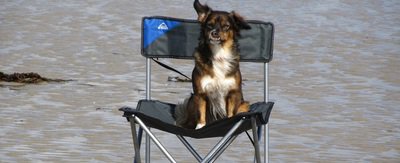
Camping chairs are a wonderful accessory to bring along on any trip and can be used to relax during downtime or sit around a campfire. However, they get dirty very easily and can be challenging to clean.
We will walk you through how to clean each type of camping chair as well as different methods for cleaning camping chairs in general.
How do you clean a camping chair?
Here are the steps to clean your camping chair.
- While the chair is dry, use a soft bristle brush to brush away loose dirt or mold.
- Spray the chair with a mixture of 1/3 water and 2/3 vinegar solution
- Use a clean clothe or soft bristle brush and work the cleaning mixture into the fabric of your camping chair.
- Use warm water to rinse the cleaning mixture, dirt, mold and debris away.
- Set your camping chair in direct sunlight and let it dry completely.
- Store your camping chair in a dry warm location until your next camping trip.

Clickable Table Of Contents
Cleaning Different Types of Camping Chairs
- Foldable Spectator Seat
The classic camping chair which can also be seen at sporting or tailgating events is a folding chair which sometimes incorporates a cooler. These chairs are usually made from canvas or polyester although some feature a lightweight mesh material for added ventilation.
Depending on the kind of chair you have, you may be able to remove the canvas entirely and put it in the washing machine. After washing, treat the material with a fabric protector that is suitable for outdoor use before putting it back on the frame.
- Zero Gravity Chair
These chairs recline like a La-Z boy and are perfect for those with back pain because they allow you to put your feet up. Usually made from a textaline fabric which is then suspended with bungees, this material is durable and perfect for the outdoors.
The durable nature of the material means it is easy to clean without damaging the fabric. However, the material cannot be removed from the chair so you may not be able to thoroughly clean it.
- Stadium Seats
These are small and lightweight enough to toss in your backpack and take anywhere with you. While they are perfect for hard bleachers, they aren’t the most comfortable when it comes to sitting on the ground.
Because these are often thick cushions, you’ll have to be careful not to soak the padding because it will take a long time to dry. If not fully dried, mold and bacteria could start to grow inside and destroy the seat.

Different Cleaning Methods
- Steam Cleaning
Use a portable or hand-held garment steamer to clean the fabric of the chair. Simply fill the chamber with clean water and aim it at any stains or dirty areas.
The method is perfect for chairs that do not have removable materials. Hot steam is also a good way to kill germs and bacteria that may be in the fabric.
One of the drawbacks is that steamers need to be plugged in so you’ll probably have to bring your dirty chairs indoors or use an extension cord to reach outside.
Small steamers can usually only provide several minutes of continuous steam so it may take several treatments and be time-consuming to clean the entire chair.
- Spray with Alcohol
Fill a plastic spray bottle with alcohol or ethanol and apply it to the chair’s fabric. Then allow the chair to dry in the sun.
The process may need to be repeated several times to get the desired results. Make sure to always test the alcohol treatment on a small, inconspicuous area of the chair first to make sure it doesn’t result in discoloration or damage to the fabric.
- Vinegar Treatment
Like alcohol, vinegar can also be used in a spray bottle and then spritzed onto the areas where there is mold or mildew. It’s not necessary to dilute the vinegar with water although you can if you want to. After spraying, wipe the chair down with a sponge to remove the vinegar.
The chair will need to dry in the sun after being treated. There is also a chance the chair will retain the smell of vinegar immediately after being cleaned, but this should dissipate with time.
To prevent a strong vinegar smell, you may want to clean it with soap after the vinegar treatment, then allow it to dry in the sun.
- Using the Washing Machine
If your chairs have removable fabric, check the labels to see if they are able to be machine washed with a mild detergent. Always use the gentle cycle and, for fragile materials like mesh, consider putting them inside a laundry bag for delicates.
- Vacuum Cleaner
For chairs that are dirty but don’t have a bunch of stains, use your household vacuum cleaner with the attachments to get a deep clean. Use the brush attachment for durable fabrics and the upholstery attachment for more delicate materials.
- Hand Wash in the Bathtub
Removable fabrics that can’t be machine washed should be hand washed in the bathtub instead. Fill the tub with warm water and add in soap or another cleanser. Then place the materials inside and submerge them.
Scrub any stains with a cloth or gentle brush to avoid damaging the fabric. Alternately, rub the fabric together to loosen dirt and debris. Let soak for several hours before rinsing thoroughly.
- Hydrogen Peroxide
Stain removal is easy with a hydrogen peroxide mix, although it is not effective on grease or oil stains. However, it works great for stains caused by food, tea or coffee, and other organic stains like grass. It disinfects and helps to eliminate odors too.
Mix two-thirds water with one-third hydrogen peroxide in a spray bottle and spot treat the stain. Let it sit for 10 to 15 minutes, depending on the toughness of the stain, and then soak up the excess moisture using a towel.
- Car Wash
The car wash is a great way to quickly clean a bunch of chairs because all the equipment is right there. Just load up the car with the chairs and use the brush to scrub them and then rinse with the power washer.
Don’t use too much pressure though or the fabric could tear. Stand a few feet from the chair and point the hose at an angle. Put down a blanket or tarp in the back of your car to transport the wet chairs home and then dry them in the sun.

Removing Stains From Your Camping Chair
- Spot Treat with Baking Soda
Most stains can be treated with a bit of baking soda and water. Sprinkle the baking soda on the stain and let it sit for a few minutes. You can vacuum the remaining soda away or, spray the stain with water and scrub it with an old toothbrush.
- Dealing with Tree Sap
Start by scraping any excess sap off with a butter knife. Use an acetone nail polish remover as a solvent to soften the sap. You can also use an enzyme-based stain remover or isopropyl alcohol.
Make sure to give it time to soften and dissolve the sap before rubbing it away. Then use heavy-duty detergent and water to scrub the stain and rinse it in hot water. Wash it again if there is a stain
- Removing Grass Stains
There are several methods to remove grass stains using at home ingredients. You can try any of the following:
- Rubbing alcohol
- Baking soda
- Vinegar
- Detergent
Just make sure to scrub the stain thoroughly and let it sit long enough for the cleaner to dissolve it, then rinse thoroughly.
- Cleaning Bird Droppings
Use a disposable utensil or twig to remove as much as possible. Then spray the chair with water and let it soak to soften any dried on residue. Disinfect the area with soap or a bleach solution.
For droppings that contain berries and can stain, use hydrogen peroxide or an oxygen-based bleach to dissolve the stain.
- Mildew Treatments
Mildew can eat the fibers of your fabric and damage or weaken a chair’s integrity so you should clean it as soon as possible. Brush or shake the item off outside and then treat any stains with liquid detergent.
Scrub it into the fibers and let it sit for about 15 minutes. Then wash it in water that is as hot as possible for the type of fabric you are cleaning. You can also use oxygen bleach to remove stains, especially on colored fabrics.
When and Where to Clean Your Chairs
It’s always best to take any dirty chairs outside to clean them, especially if mold or mildew is present. You’ll want an open or well-ventilated area so that the air can be vented.
Put down some old newspaper or a tarp if you don’t want the area to get dirty, such as a garage floor or patio. This is also necessary to catch any spores so they don’t get on anything else.
Choose a clear, sunny day to do your cleaning because the chairs will need to sit outside in the sun after being washed. If it is rainy or overcast, you run the risk of the chairs mildewing because they will not be able to dry thoroughly.
Start as early as possible in the day so there is adequate time for the chairs to sit in the sun after they are clean. The amount of time needed will depend on the fabric and whether or not there is padding that was washed too.

DIY Camping Chair Cleaner
If you have a lot of folding chairs to wash, you can make your own device to clean them. Stop by the hardware store and pick up a tall plastic trash can, some broom heads, and the necessary nuts and bolts.
Then drill holes in the can and through the broom heads so that the bristles face inward. You can then fill the fan with water and quickly move the chair in and out. Then turn it over and do the other side.
This is a quick way to clean the chair without scrubbing it by hand. It may be difficult to spot treat certain areas since the brushes are larger, but it is an easy way to quickly clean chairs. Use the brooms without water to remove dust and cobwebs when the chairs come out of storage.
More great articles you will want to read.
How to Clean a Camping Pillow ( methods and what to avoid )
Using a tarp for camping ( 17 Must know hacks )

